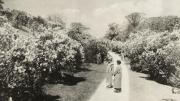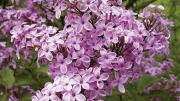They ravish the eye. They intoxicate the nose. For more than a century, susceptible folk have come in mid May to a “Lilac Sunday” festival at the Arnold Arboretum to revel in one of North America’s oldest and largest collections of lilacs. (The ladies above are taking them in in 1926.) Grouped together today are more than 375 lilac bushes of 180 kinds. They include both pure species and nearly 140 cultivars, plants selected and named because of certain horticultural merits—color, scent, flower size, or habit of growth.
Although lilacs have adorned the American landscape for many years—George Washington and Thomas Jefferson write of planting them—like most of us they are not native here. Of the 20-plus species, two come from Europe, the rest from Asia. The common lilac, Syringa vulgaris, is an East European. It was so energetically grown and selected by French nurserymen that that country earned a reputation for fine lilacs, the so-called French hybrids. Now Russian, American, and Canadian hybridizers have joined the party.
In 1978, John H. Alexander III, plant propagator of the Arnold Arboretum, searched a list of seed offered for sharing by the Botanical Garden of the Chinese Botanical Academy in Beijing. On it was a lilac; it was of uncertain identity, but Alexander wanted to grow it anyway. He sent for the seed and planted it in Boston the next year. Eighteen seeds germinated. One of the resulting plants turned out to be exceptional, and he introduced it as Syringa x chinensis ‘Lilac Sunday’. “With the number of lilac cultivars approaching a thousand,” he wrote in a 1997 issue of the arboretum’s magazine Arnoldia, “the decision to add yet another can’t be taken lightly, even though…S. x chinensis can claim less than 20 cultivars.” Alexander selected ‘Lilac Sunday’ for its fragrance, color, abundance of flower, and especially its growth habit: it produces flower panicles not only at the branch tips, like the common lilac, but along the stems, weighing the arching branches down with blossom. ‘Lilac Sunday’ struts its stuff above left. Get the full impact—scheduled this year for Mother’s Day, May 13—at the one-hundred-and-fourth Lilac Sunday.









